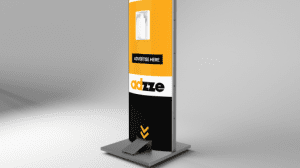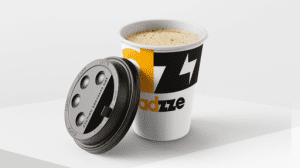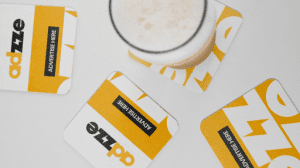In the realm of advertising, success is often measured by immediate results—clicks, likes, shares, and sales spikes. But what happens after the buzz dies down? The true value of a viral guerrilla marketing campaign lies not only in the initial splash it makes but also in its long-tail impact. This ripple effect extends beyond the campaign’s lifespan, influencing brand perception, customer loyalty, and even long-term sales. Understanding how to measure and maximize this ripple effect is essential for marketing professionals aiming to create campaigns with lasting impact.
In this blog, we’ll explore the concept of the long-tail impact of viral guerrilla campaigns, discuss unconventional advertising methods, and highlight how Adzze’s innovative media options can play a pivotal role in amplifying and sustaining a campaign’s influence. By the end, you’ll have actionable insights to track and optimize the ripple effect of your next campaign.

The Nature of the Long-Tail Impact in Viral Guerrilla Marketing
Guerrilla marketing is designed to surprise, engage, and leave a lasting impression. It’s a form of unconventional advertising that thrives on creativity and disruption. Viral campaigns take this a step further by leveraging the power of social sharing to amplify their reach. However, the ripple effect—the sustained influence of a campaign after its initial wave—can be even more valuable.
What Is the Ripple Effect?
The ripple effect refers to the continued impact of a marketing campaign over time. This includes increased brand recall, word-of-mouth recommendations, and long-term shifts in customer behavior. While the initial wave of a viral campaign generates buzz and engagement, the ripples create lasting value.
For example, consider the famous “Fearless Girl” statue placed opposite the Wall Street Bull. What started as a bold guerrilla marketing stunt became a global conversation about gender equality in the workplace. Years later, the statue continues to be a symbol of empowerment, demonstrating the enduring impact of a well-executed campaign.
The Challenges of Measuring the Long-Tail Impact
Tracking the long-tail impact of a viral guerrilla campaign is no easy task. Unlike traditional advertising, where metrics like click-through rates and conversions provide immediate feedback, the effects of guerrilla marketing can be more abstract and spread over time.
1. Lack of Direct Attribution
One of the biggest challenges is attributing long-term outcomes to a specific campaign. For instance, how do you measure the contribution of a guerrilla campaign to increased sales six months later when other factors are also at play?
2. Difficulty in Tracking Word-of-Mouth
Guerrilla campaigns often rely on word-of-mouth and organic sharing, which are challenging to quantify. While digital shares and likes are easy to track, offline conversations are harder to measure.
3. Limited Access to Sentiment Analysis
While social listening tools can provide insights into how people are discussing a campaign online, gauging the overall sentiment and depth of those conversations requires more advanced analytics.
Strategies for Measuring the Long-Tail Impact
Despite these challenges, there are effective ways to track the ripple effect of a guerrilla marketing campaign. Here are some strategies to consider:
1. Monitor Social Media Metrics Beyond the Campaign Period
Social media remains one of the most accessible tools for measuring long-term impact. Instead of focusing solely on metrics like likes and shares during the campaign’s active phase, monitor mentions, hashtags, and engagement over an extended period.
For example, a successful guerrilla campaign that incorporates Adzze’s restaurant takeout bag advertising could be tracked by analyzing hashtag use on social media months after the campaign has ended.
2. Use Google Trends to Monitor Brand Interest
Google Trends is a powerful tool for tracking changes in brand interest over time. After a viral campaign, monitor search volumes for your brand name or related keywords to see if interest remains elevated.
3. Conduct Post-Campaign Surveys
Surveys are an effective way to measure brand recall and sentiment among your target audience. Ask respondents if they remember the campaign and whether it influenced their perception of the brand.
4. Leverage Customer Loyalty Data
Guerrilla campaigns often aim to create emotional connections with customers. Use loyalty program data to track whether customers acquired during the campaign period continue to engage with your brand over time.
5. Analyze Sales and Foot Traffic Data
For campaigns tied to specific locations or events, track sales and foot traffic before, during, and after the campaign. Adzze’s branded coffee sleeves are an excellent example of how a seemingly small advertising touchpoint can drive repeat visits and long-term brand loyalty.
Adzze’s Role in Amplifying the Ripple Effect
Adzze specializes in unconventional advertising solutions that are perfect for guerrilla marketing campaigns. By placing your brand directly in the hands of consumers, Adzze ensures that your message is not only seen but also engaged with on a personal level.
Branded Coffee Sleeves
Imagine your message on a coffee sleeve that’s carried into offices, meetings, and public spaces. This not only increases brand visibility but also creates opportunities for organic sharing. A clever design or a witty tagline can spark conversations and extend the life of your campaign.
Hand Sanitizer Advertising
Hand sanitizers are a practical and highly visible medium, especially in high-traffic areas. By branding hand sanitizers, you’re providing a useful product while reinforcing your message every time it’s used.
Pizza Box Advertising
Pizza boxes are another example of an unconventional medium that drives long-term impact. Shared in homes and offices, branded pizza boxes ensure that your campaign reaches a captive audience in a relaxed and receptive setting.
Bar Coaster Advertising
Bar coaster advertising is an innovative way to get your brand message noticed in social settings. Bars and pubs are ideal for reaching relaxed and engaged audiences who are likely to spend extended periods of time at a venue. With the right design and message, a branded coaster can spark curiosity, encourage social media sharing, and keep your brand top of mind long after the drink is finished.
Hotel Key Card Advertising
Hotel key cards are a high-impact, low-effort way to put your brand in the hands of travelers. Every guest interacts with their key card multiple times during their stay, ensuring repeated exposure to your message. Whether you’re promoting a local event, a nearby attraction, or a service, hotel key cards provide direct, uninterrupted engagement with a captive audience.
Placemat Advertising
Placemat advertising is an ideal choice for restaurants, cafes, and diners. Placemats are unavoidable and highly visible, often staying in front of customers for the entirety of their meal. This extended dwell time allows your brand message to resonate deeply, especially when combined with engaging designs or promotional offers. Placemat advertising works particularly well for targeting families, casual diners, and groups.
Each of these solutions integrates seamlessly into daily routines, transforming ordinary items into powerful marketing tools. By leveraging Adzze’s diverse media options, you can amplify the ripple effect of your guerrilla campaigns, ensuring that your brand remains memorable and impactful long after the initial touchpoint.






Case Studies: The Ripple Effect in Action
1. A Grocery Chain’s Guerrilla Campaign
A regional grocery chain used branded takeout bags from Adzze to promote a new organic product line. While the initial buzz lasted a few weeks, sales data revealed a sustained increase in organic product purchases for over six months, demonstrating the long-tail impact of the campaign.
2. A Fitness Brand’s Viral Coffee Sleeve Campaign
A fitness brand partnered with Adzze to distribute coffee sleeves featuring a QR code for a free trial at local gyms. While the initial campaign generated a spike in sign-ups, customer surveys revealed that the gym trial encouraged long-term memberships.
3. A Tech Startup’s Pizza Box Strategy
A tech startup used branded pizza boxes to advertise a new app. The campaign went viral on social media, and app downloads continued to rise steadily for months, supported by word-of-mouth recommendations.
What challenges does a guerrilla marketer face when running viral campaigns?
Easy as it might sound, viral marketing is quite an uphill task to the guerrilla marketer. One of the biggest challenges faced in creation of good content. According to Hubspot, the scale at which the content goes viral depends on the nature of content. Usually, content that makes people hooked to their devices has better chances of going viral.
The second challenge is access to a good platform. Today, there are numerous social media platforms but each one treats viral content differently. This is because of the demographic that makes the majority on each platform. Thirdly, a guerrilla marketer faces the challenge of converting the views into direct actions. While many people might view the viral content, just a few might actually follow up with direct actions.
Unconventional advertising is ideal for higher engagement rates
Unconventional advertising encompasses all the tactics that leverage on the surprise element to increase brand engagement. Admittedly, all advertisers desire to earn as much engagement rates as the impression rates. Particularly, this is a huge problem for traditional media because of their inability to attract enough attention.
On the contrary, unconventional advertising techniques startle customers because they do not expect to see ads in certain places. Subsequently, the customers grow interested in the brand, which leads to higher engagement rates. Unconventional ads are cheap to implement and easy to produce. Therefore, advertisers have a chance to earn many customers at a discount.
Ambient Media
An emerging unconventional advertising tactics is Ambient Media. This concept is usually applied by niche advertising agencies that aim to overcome traditional methods of advertising to get the attention of consumers. Traditional advertising has been witnessing a decline in the effectiveness so there is a greater demand for point-of-sale communications and its ability to offer precise audience targeting. Another factor that contribute to the success of agencies using ambient media is the smart way to regain consumers attention as marketers target on creating an incongruent stimuli that evokes surprise by placing ads in unusual locations and with unconventional methods that had never used before.
As example of ambient media that agencies have been using as innovative method is daily consumables. Brands seek to attain audience’s attention by placing ads on consumables that the target audience must touch creating a surprising effect. Such consumables can be: door hangers, pizza box toppers, prescription bags, drink coasters, Custom Coffee Sleeves, hotel key cards, valet tickets, restaurant placemats and dry cleaner hangers.
Here some practical examples:
1. An anti-DIU awareness campaign that can be placed on beer coasters in NYC bars
2. Healthy food provider places an ad on branded pharmacy bags in reputable pharmacy venues close to hospitals
3. The new entertainment business offering a ticket discounts on coffee cups aiming to target millennials
4. A high-end service advertised on hotel room key cards: perfect tactics to target affluent travelers
5. The new sports center offering a promo code on pizza boxes after eating a certain amount of calories!
The Future of Measuring Guerrilla Campaigns
As technology evolves, so do the tools available for tracking the impact of guerrilla marketing campaigns. Artificial intelligence and machine learning are making it easier to analyze sentiment, predict trends, and attribute outcomes to specific campaigns. Additionally, the integration of offline and online data sources will provide a more comprehensive view of a campaign’s ripple effect.
Conclusion: Creating Campaigns with Enduring Impact
The true success of a guerrilla marketing campaign lies not only in its ability to generate immediate buzz but also in its capacity to create lasting ripples. By understanding the long-tail impact, leveraging unconventional advertising methods like those offered by Adzze, and employing effective tracking strategies, brands can maximize the value of their campaigns.






